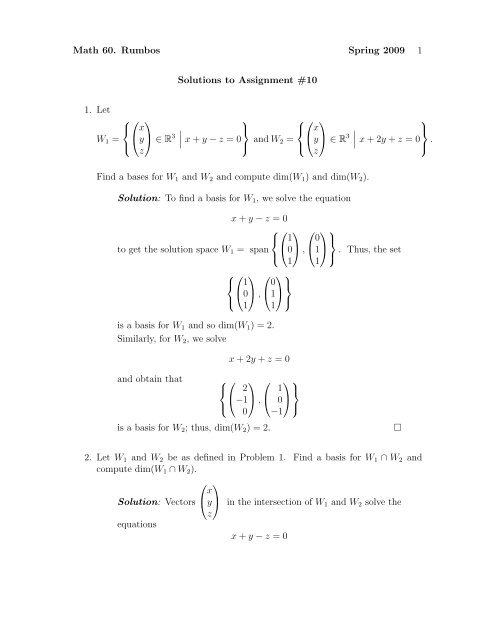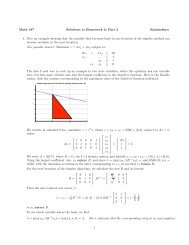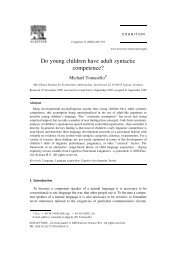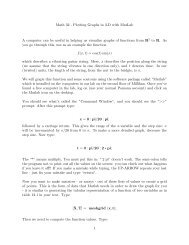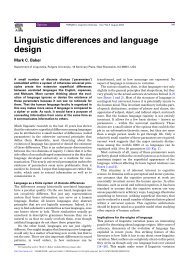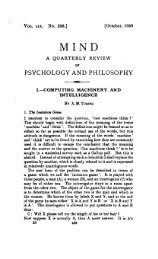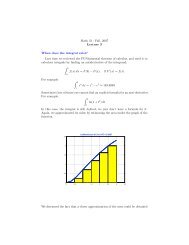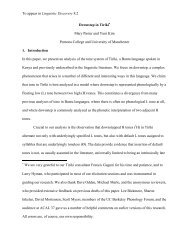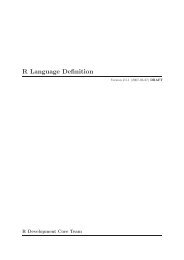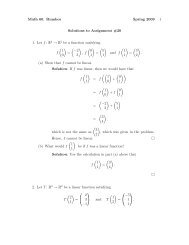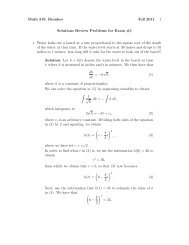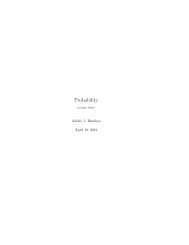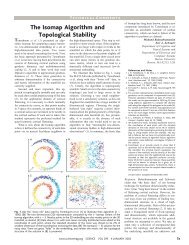Math 60. Rumbos Spring 2009 1 Solutions to Assignment #10 1. Let ...
Math 60. Rumbos Spring 2009 1 Solutions to Assignment #10 1. Let ...
Math 60. Rumbos Spring 2009 1 Solutions to Assignment #10 1. Let ...
You also want an ePaper? Increase the reach of your titles
YUMPU automatically turns print PDFs into web optimized ePapers that Google loves.
<strong>Math</strong> <strong>60.</strong> <strong>Rumbos</strong> <strong>Spring</strong> <strong>2009</strong> 1<strong>Solutions</strong> <strong>to</strong> <strong>Assignment</strong> <strong>#10</strong><strong>1.</strong> <strong>Let</strong>⎧⎛⎞⎫ ⎧⎛⎞⎫⎨ x ∣ ⎬ ⎨ x ∣ ⎬W 1 = ⎝y⎠ ∈ R 3 ∣∣ x + y − z = 0⎩⎭ and W 2 = ⎝y⎠ ∈ R 3 ∣∣ x + 2y + z = 0⎩⎭ .zzFind a bases for W 1 and W 2 and compute dim(W 1 ) and dim(W 2 ).Solution: To find a basis for W 1 , we solve the equationx + y − z = 0⎧⎛⎞ ⎛ ⎞⎫⎨ 1 0 ⎬<strong>to</strong> get the solution space W 1 = span ⎝0⎠ , ⎝1⎠. Thus, the set⎩⎭1 1⎧⎛⎞ ⎛ ⎞⎫⎨ 1 0 ⎬⎝0⎠ , ⎝1⎠⎩⎭1 1is a basis for W 1 and so dim(W 1 ) = 2.Similarly, for W 2 , we solvex + 2y + z = 0and obtain that ⎧ ⎞ ⎛ ⎞⎫⎨ 2 1 ⎬⎝−1⎠ , ⎝ 0⎠⎩⎛⎭0 −1is a basis for W 2 ; thus, dim(W 2 ) = 2.□2. <strong>Let</strong> W 1 and W 2 be as defined in Problem <strong>1.</strong> Find a basis for W 1 ∩ W 2 andcompute dim(W 1 ∩ W 2 ).⎛ ⎞xSolution: Vec<strong>to</strong>rs ⎝y⎠ in the intersection of W 1 and W 2 solve thezequationsx + y − z = 0
<strong>Math</strong> <strong>60.</strong> <strong>Rumbos</strong> <strong>Spring</strong> <strong>2009</strong> 2andx + 2y + z = 0simultaneously. Therefore, <strong>to</strong> find W 1 ∩ W 2 , we need <strong>to</strong> solve thesystem of equations{ x + y − z = 0x + 2y + z = 0.(1)We therefore perform elementary row operations on the augmentedmatrix( )R 1 1 1 −1 | 0R 2 1 2 1 | 0<strong>to</strong> obtain the reduced matrix( )1 0 −3 | 0.0 1 2 | 0Thus, the system in (1) is equivalent <strong>to</strong>{ x − 3z = 0y + 2z = 0,⎧⎛⎨from which we obtain that W 1 ∩ W 2 = span ⎝⎩set ⎧ ⎞⎫⎨ 3 ⎬⎝−2⎠⎩⎛⎭1⎞⎫3 ⎬⎠ . Thus, the⎭−21is a basis for W 1 ∩ W 2 and, therefore, dim(W 1 ∩ W 2 ) = <strong>1.</strong>□3. <strong>Let</strong> W 1 and W 2 be as defined in Problem <strong>1.</strong> Find a basis for W 1 + W 2 andcompute dim(W 1 + W 2 ).Use the results of Problems 1 and 2 <strong>to</strong> verify thatdim(W 1 + W 2 ) = dim(W 1 ) + dim(W 2 ) − dim(W 1 ∩ W 2 ).
<strong>Math</strong> <strong>60.</strong> <strong>Rumbos</strong> <strong>Spring</strong> <strong>2009</strong> 3⎧⎛⎞ ⎛ ⎞⎫⎧⎛⎨ 1 0 ⎬ ⎨Solution: Since W 1 = span ⎝0⎠ , ⎝1⎠⎩⎭ and W 2 = ⎝⎩1 1it follows from Problem 4 in <strong>Assignment</strong> #8 that⎧⎛⎞ ⎛ ⎞ ⎛ ⎞ ⎛ ⎞⎫⎨ 1 0 2 1 ⎬W 1 + W 2 = span ⎝0⎠ , ⎝1⎠ , ⎝−1⎠ , ⎝ 0⎠⎩⎭ .1 1 0 −1⎞ ⎛2⎠ , ⎝Thus, in order <strong>to</strong> find a basis for W 1 + W 2 , we need <strong>to</strong> find a linearlyindependent subset of⎧⎛⎞ ⎛ ⎞ ⎛ ⎞ ⎛ ⎞⎫⎨ 1 0 2 1 ⎬⎝0⎠ , ⎝1⎠ , ⎝−1⎠ , ⎝ 0⎠⎩⎭ .1 1 0 −1which also spans W 1 + W 2 . To do this, label the vec<strong>to</strong>rs v 1 , v 2 , v 3 andv 4 , respectively, and consider the vec<strong>to</strong>r equation:−10c 1 v 1 + c 2 v 2 + c 3 v 3 + c 4 v 4 = 0, (2)where 0 denotes the zero–vec<strong>to</strong>r in R 3 . This equation is equivalent <strong>to</strong>the the homogeneous system⎧⎨⎩c 1 + 2c 3 + c 4 = 0c 2 − c 3 = 0c 1 + c 2 − c 4 = 0.The augmented matrix of this system is:R 1⎛1 0 2 1 |⎞0R 2⎝ 0 1 −1 0 | 0 ⎠ ,R 3 1 1 0 −1 | 0which can be reduced <strong>to</strong>⎛1 0 0 −3 |⎞0⎝ 0 1 0 2 | 0 ⎠ .0 0 1 2 | 0Thus, the system in (3) is equivalent <strong>to</strong> the system⎧⎨ c 1 − 3c 4 = 0c 2 + 2c 4 = 0⎩c 3 + c 4 = 0.(3)⎞⎫1 ⎬⎠⎭ ,0−1
<strong>Math</strong> <strong>60.</strong> <strong>Rumbos</strong> <strong>Spring</strong> <strong>2009</strong> 4Hence, the solutions <strong>to</strong> the vec<strong>to</strong>r equation in (2) are⎧c 1 = 3t⎪⎨c 2 = −2tc 3 = −2t⎪⎩c 4 = t,(4)where t is an arbitrary parameter. Taking t = 1 in (4) yields from (2)the linear relation−3v 1 − 2v 2 − 2v 3 + v 4 = 0,which shows that v 4 = −3v 1 +2v 2 +2v 3 ; that is, v 4 ∈ span{v 1 , v 2 , v 3 }.Consequently,from which we get that{v 1 , v 2 , v 3 , v 4 } ⊆ span{v 1 , v 2 , v 3 },span{v 1 , v 2 , v 3 , v 4 } ⊆ span{v 1 , v 2 , v 3 },since span{v 1 , v 2 , v 3 , v 4 } is the smallest subspace of R 3 which contains{v 1 , v 2 , v 3 , v 4 }. Combining this withwe conclude thatspan{v 1 , v 2 , v 3 } ⊆ span{v 1 , v 2 , v 3 , v 4 },span{v 1 , v 2 , v 3 } = span{v 1 , v 2 , v 3 , v 4 };that is {v 1 , v 2 , v 3 } spans W 1 + W 2 .Next, we show that {v 1 , v 2 , v 3 } is linearly independent. This time weconsider the vec<strong>to</strong>r equationc 1 v 1 + c 2 v 2 + c 3 v 3 = 0, (5)where 0 denotes the zero–vec<strong>to</strong>r in R 3 . This equation is equivalent <strong>to</strong>the the homogeneous system⎧⎨⎩c 1 + 2c 3 = 0c 2 − c 3 = 0c 1 + c 2 = 0.
<strong>Math</strong> <strong>60.</strong> <strong>Rumbos</strong> <strong>Spring</strong> <strong>2009</strong> 5The augmented matrix of this system is:R 1⎛1 0 2 |⎞0R 2⎝ 0 1 −1 | 0 ⎠ ,R 3 1 1 0 | 0which can be reduced <strong>to</strong>⎛⎝1 0 0 |⎞00 1 0 | 0 ⎠ .0 0 1 | 0Then, the vec<strong>to</strong>r equation (5) has only the trivial solution, and therefore,{v 1 , v 2 , v 3 } is linearly independent. Hence, the set⎧⎛⎞ ⎛ ⎞ ⎛ ⎞⎫⎨ 1 0 2 ⎬⎝0⎠ , ⎝1⎠ , ⎝−1⎠⎩⎭ .1 1 0is a basis for W 1 + W 2 and therefore dim(W 1 + W 2 ) = 3.Observe that the equationdim(W 1 + W 2 ) = dim(W 1 ) + dim(W 2 ) − dim(W 1 ∩ W 2 )is verified since3 = 2 + 2 − <strong>1.</strong>□⎛1 −2 −3⎞04. <strong>Let</strong> A = ⎝−1 0 2 1 ⎠ .1 4 0 −3(a) Find a basis for the column space, C A , of the matrix A and computedim(C A ).Solution: C A is the span of the columns of A:⎧⎛⎞ ⎛ ⎞ ⎛ ⎞ ⎛ ⎞⎫⎨ 1 −2 −3 0 ⎬C A = span ⎝−1⎠ , ⎝ 0 ⎠ , ⎝ 2 ⎠ , ⎝ 1 ⎠⎩⎭ .1 4 0 −3Denote the columns of A by v 1 , v 2 , v 3 and v 4 , respectively. Tofind a basis for C 4 , we need <strong>to</strong> find a linearly independent subset
<strong>Math</strong> <strong>60.</strong> <strong>Rumbos</strong> <strong>Spring</strong> <strong>2009</strong> 6of {v 1 , v 2 , v 3 , v 4 } which also spans C A . In order <strong>to</strong> do this, we seekfor nontrivial solutions <strong>to</strong> the vec<strong>to</strong>r equation:c 1 v 1 + c 2 v 2 + c 3 v 3 + c 4 v 4 = 0, (6)where 0 denotes the zero–vec<strong>to</strong>r in R 3 . This equation is equivalent<strong>to</strong> the the homogeneous system⎧⎨⎩c 1 − 2c 2 − 3c 3 = 0−c 1 + 2c 3 + c 4 = 0c 1 + 4c 2 − 3c 4 = 0.The augmented matrix of this system is:R 1⎛1 −2 −3 0 |⎞0R 2⎝−1 0 2 1 | 0 ⎠ ,R 3 1 4 0 −3 | 0which can be reduced <strong>to</strong> the matrix⎛1 0 −2 −1 |⎞0⎝ 0 1 1/2 −1/2 | 0 ⎠ .0 0 0 0 | 0(7)We therefore get that the system in (7) is equivalent <strong>to</strong>{c1 − 2c 3 − c 4 = 0c 2 + (1/2)c 3 − (1/2)c 4 = 0,Solving for the leading variables in (8) yields the solutions⎧c 1 = 4t + 2s⎪⎨c 2 = −t + sc 3 = 2t⎪⎩c 4 = 2s,(8)(9)where t and s are arbitrary parameters.Taking t = 1 and s = 0 in (9) yields from (6) the linear relation4v 1 − v 2 + 2v 3 = 0,which shows that v 3 = −4v 1 + v 2 ; that is, v 3 ∈ span{v 1 , v 2 }.Similarly, taking t = 0 and s = 1 in (9) yields2v 1 + v 2 + 2v 4 = 0,
<strong>Math</strong> <strong>60.</strong> <strong>Rumbos</strong> <strong>Spring</strong> <strong>2009</strong> 7which shows that v 4 = −(1/2)v 1 −(1/2)v 2 ; that is, v 4 ∈ span{v 1 , v 2 }.We then have that both v 3 and v 4 are in the span of {v 1 , v 2 }.Consequently,from which we get that{v 1 , v 2 , v 3 , v 4 } ⊆ span{v 1 , v 2 },span{v 1 , v 2 , v 3 , v 4 } ⊆ span{v 1 , v 2 },since span{v 1 , v 2 , v 3 , v 4 } is the smallest subspace of R 3 which contains{v 1 , v 2 , v 3 , v 4 }. Combining this withwe conclude thatspan{v 1 , v 2 } ⊆ span{v 1 , v 2 , v 3 , v 4 },span{v 1 , v 2 } = span{v 1 , v 2 , v 3 , v 4 };that is {v 1 , v 2 } spans C A . Set B = {v 1 , v 2 }.It remains <strong>to</strong> show that B is linearly independent. To prove this,consider the vec<strong>to</strong>r equationwhich leads <strong>to</strong> the system⎧c 1 − 2c 2 = 0⎪⎨−c 2 = 0−c 1 = 0⎪⎩c 1 + 4c 2 = 0,c 1 v 1 + c 2 v 2 = 0, (10)which can be seen <strong>to</strong> have only the trivial solution: c 1 = c 2 = 0.It then follows that the vec<strong>to</strong>r equation (10) has only the trivialsolution, and therefore B is linearly independent. We thereforeconclude that the set⎧⎛⎞ ⎛ ⎞⎫⎨B = ⎝⎩1−11is a basis for C A . Hence, dim(C A ) = 2.−2 ⎬⎠ , ⎝ 0 ⎠⎭4(b) Find a basis for the null space, N A , of the matrix A and compute dim(N A ).□
<strong>Math</strong> <strong>60.</strong> <strong>Rumbos</strong> <strong>Spring</strong> <strong>2009</strong> 8Solution: N A is the solution space of the homogeneous system⎧⎨ c 1 − 2c 2 − 3c 3 = 0−c 1 + 2c 3 + c 4 = 0(11)⎩c 1 + 4c 2 − 3c 4 = 0.which is the same as system (7) in the previous part. Therefore,system (11) is equivalent <strong>to</strong> the reduced system{c1 − 2c 3 − c 4 = 0(12)c 2 + (1/2)c 3 − (1/2)c 4 = 0,Hence, N A is the same as the solution space of system (12), whichis given by ⎧⎪ ⎨⎪ ⎩c 1 = 4t + 2sc 2 = −t + sc 3 = 2tc 4 = 2s,where t and s are arbitrary parameters. Thus,⎧⎛⎞ ⎛ ⎞⎫4 2⎪⎨N A = span ⎜−1⎟⎝ 2⎠ ⎪⎩, ⎜−1⎪⎬⎟⎝ 0⎠.⎪⎭0 −1Since the set⎛ ⎞ ⎛ ⎞⎫⎧⎪ 4 2⎨ ⎜−1⎟⎝⎪ 2⎠ , ⎜−1⎪⎬⎟⎝ 0⎠⎩ ⎪⎭0 −1is linearly independent, it forms a basis for N A . Therefore, dim(N A ) =2. □(c) Compute dim(N A ) + dim(C A ). What do you observe?Solution: dim(N A ) + dim(C A ) = 2 + 2, which is the number ofcolumns of A.□5. <strong>Let</strong> A denote the matrix defined in the previous problem. Consider the rows ofA as row vec<strong>to</strong>rs in R 4 , and let R A denote the span of the rows of the matrixA. Find a basis for R A , and compute dim(R A ). What do you find interestingabout dim(R A ) and dim(C A ), which was computed in the previous problem.
<strong>Math</strong> <strong>60.</strong> <strong>Rumbos</strong> <strong>Spring</strong> <strong>2009</strong> 9Solution: Denote the rows of A by R 1 , R 2 and R 3 , respectively:R 1⎛1 −2 −3⎞0R 2⎝−1 0 2 1 ⎠ .R 3 1 4 0 −3Perform elementary row operations on this matrix, but this time keeptrack of them <strong>to</strong> obtain:R 1⎛1 0 −2⎞−1R 1 + R 2⎝ 0 −2 −1 1 ⎠ ,−R 1 + R 3 0 6 3 −3followed byR 1R 1 + R 23(R 1 + R 2 ) + (−R 1 + R 3 )⎛⎝1 0 −2 −10 −2 −1 10 0 0 0⎞⎠ .Observe that the last row is made up of zeros from which we get that2R 1 + 3R 2 + R 3 = O,where O denotes a row of four zeros. We then obtain thatwhich shows thatThus,Thus,We therefore conclude thatR 3 = −2R 1 − 3R 3 ,R 3 ∈ span{R 1 , R 2 }.{R 1 , R 2 , R 3 } ⊆ span{R 1 , R 2 }.span{R 1 , R 2 , R 3 } ⊆ span{R 1 , R 2 }.R A = span{R 1 , R 2 }.Since R 1 and R 2 are not multiples of each other, the set {R 1 , R 2 } islinearly independent. We therefore get that dim(R A ) = 2. Observethat this is the same as the dimension of C A .□


